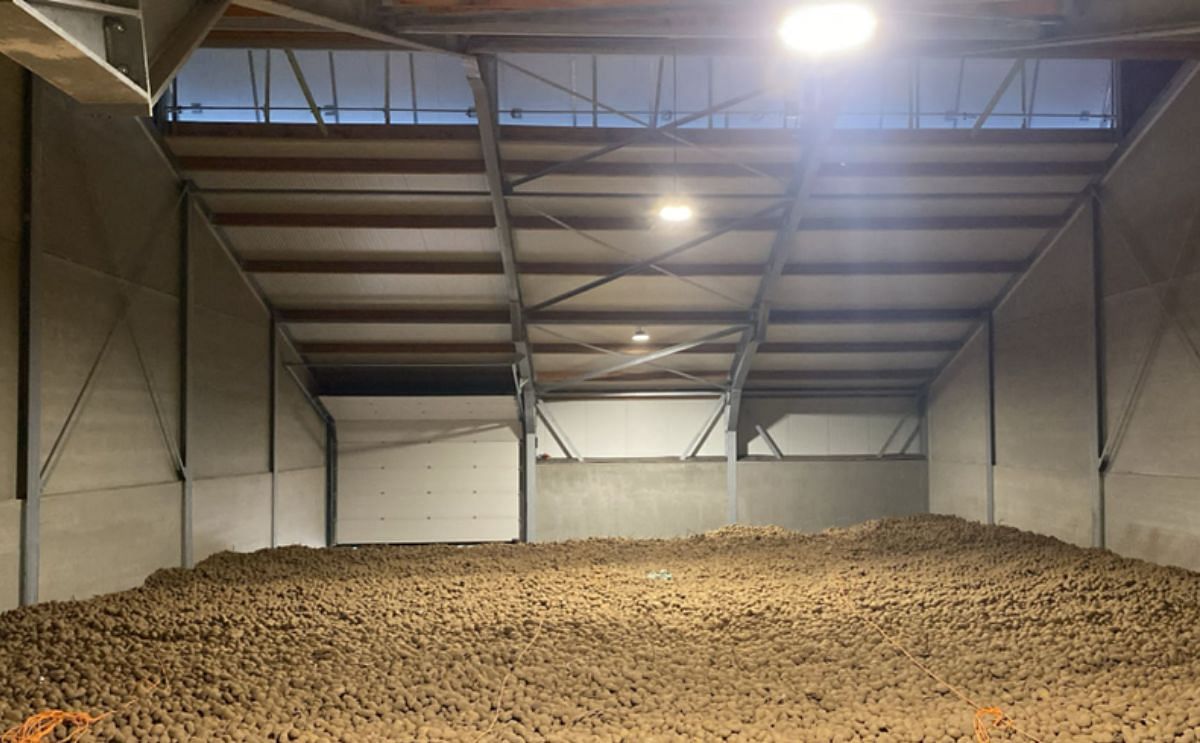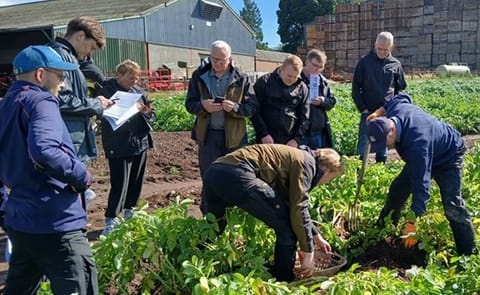Tough harvest, how to proceed in storage?
Tough harvest, how to proceed in storage?

The storage season for potatoes is in full swing and has proven to be quite a challenge so far. Batches are difficult to dry and it is very difficult to find the right conditions to quickly complete the wound healing process. This is sometimes accompanied by losses. Tolsma-Grisnich provides some tips for drying and storing of challenging potato crops...
Harvesting conditions are not easy this season on both clay and sandy soils. Potatoes are coming in covered with mud and storage is quite a challenge and with some lots storage is not an option at all.
Jasper van de Braak, storage advisor at Tolsma-Grisnich:
Jasper van de Braak:
Jasper van de Braak:
Jasper van de Braak:
With the current outside temperature, the drying capacity is extremely high. But according to Van de Braak, the trick is not to make the batch too cold too quickly.
Jasper van de Braak:
Harvesting conditions are not easy this season on both clay and sandy soils. Potatoes are coming in covered with mud and storage is quite a challenge and with some lots storage is not an option at all.
Jasper van de Braak, storage advisor at Tolsma-Grisnich:
"Even lots that came in under reasonable conditions earlier this season require a lot of extra attention."In his working area in eastern North Brabant and the province of Limburg, the Netherlands, he sees many challenges with drying potatoes and that is not always without losses.
Jasper van de Braak:
"With the harvesting conditions since mid-October, potatoes often arrive wet and/or with a lot of soil. This means that it is very difficult to find the drying conditions for the right balance between wound healing and preventing wetness and bacteria from affecting healthy potatoes."As a result, many lots have been behind the shelves for some time but are still fully in the drying phase.
Jasper van de Braak:
"A customer of mine had harvested a batch that was still in reasonable conditions compared to now, before the heaviest rain. This batch had arrived at around 14°C with little rot at first glance."This is about a batch on a slatted floor with AC fans, with a Vision Control storage computer and heater automation.
"That seemed to go well in the beginning, but from experience in the field it was known that there were places on the plot that could cause problems during storage. Just two weeks later that happened and rot and leaking tubers emerged."
Jasper van de Braak:
"To get the batch under control, we have tried to keep the batch at a constant temperature of 14°C. The higher the temperature, the faster the wound healing."Cold and warmer period
"You want the wound healing to be completed as quickly as possible to prevent further spread of diseases to the healthy tubers. For example, wound healing at 12°C takes an average of 28 days, at 15°C it takes twenty days and at 18°C about fourteen days."
"But if your storage temperature is above 15°C, bacteria and rot will spread more quickly. The correct temperature is therefore crucial to prevent further spread."
"Fortunately, the weather was reasonably suitable for this and maximum external ventilation was then maintained and this was maintained for two weeks."
"After that, external ventilation was reduced somewhat and a switch was made to regular internal ventilation, with the fans running for 45 minutes every three hours."
With the current outside temperature, the drying capacity is extremely high. But according to Van de Braak, the trick is not to make the batch too cold too quickly.
Jasper van de Braak:
"You then have a smaller RH difference and therefore less drying capacity because of the smaller difference in temperature. With the current, cooler weather and a heater, drying runs smoothly. But when a warmer period arrives, such as Christmas last year, then you can hardly dry and it is more difficult to keep your batch at the right temperature."In addition, there are a number of other useful tips for drying and storing the potatoes:
- In addition, place the heater(s) at the front of the storage door and not along the side, so that the heat is spread evenly throughout the storage area. If you do not do this, there is a chance that the temperature difference in the batch will increase and condensation will form and the potatoes will become wet.
- If potatoes arrive too cold, it is advisable to place your heater immediately and set it 2°C higher than your product temperature. The heat from the heater is necessary to prevent the tubers from cooling further due to drying (evaporation of moisture). You want to prevent your batch from dropping too quickly in temperature. Below 12 °C, wound healing hardly takes place. Ideally, you would also like to warm up very cold potatoes a bit so that you still have drying options during periods of warmer weather.
- If you have just entered the storage phase, but the batch still needs to lose some moisture, you can choose to reduce the difference between the duct and product temperatures. This is often set to 2°C and now you set it to 1 or 1.5°C. This means that less cold air is blown into the duct and the cooling action takes longer. This way you lose some more moist. In situations with a lot of rot/soil it is better to let the drying phase last a little longer before switching to the storage phase.
Like to receive news like this by email? Join and Subscribe!
Get the latest potato industry news straight to your WhatsApp. Join the PotatoPro WhatsApp Community!
Highlighted Company
Sponsored Content
Sponsored Content
Sponsored Content
Sponsored Content








